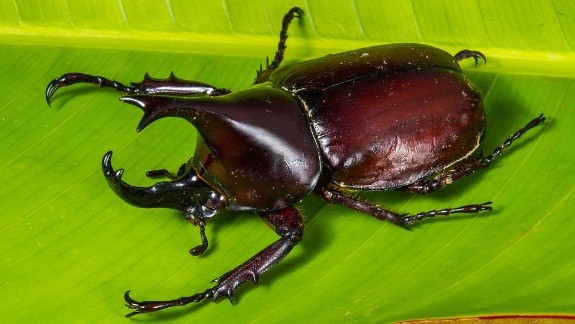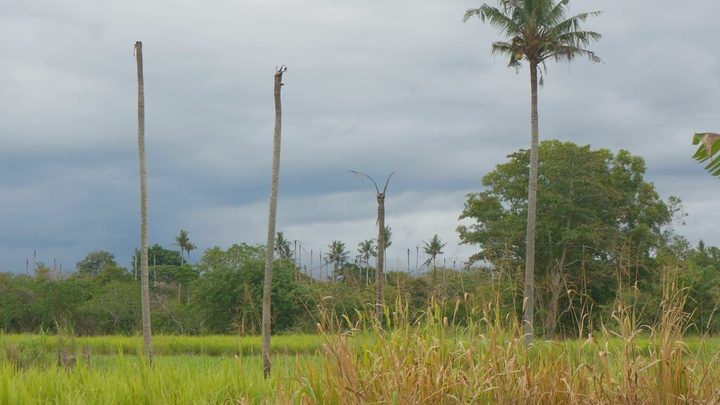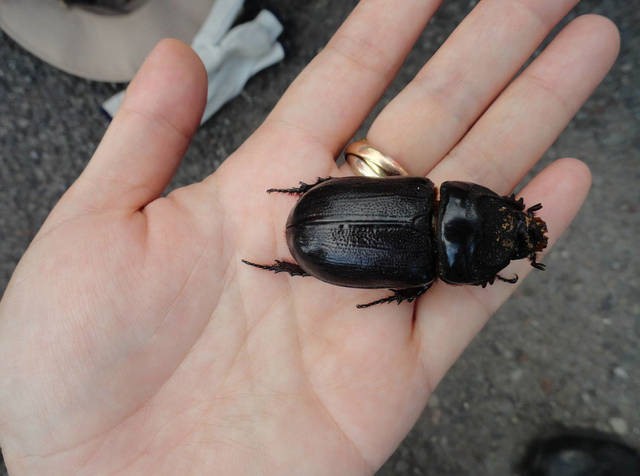They are called rhino beetles because they have a horn on their heads that looks like a rhino horn!

Rhinoceros Beetles are among the largest of beetles in the world. The Rhinoceros Beetle is aptly named because it has horns on its head, very much like the rhinoceros does.
Rhinoceros Beetles are among the largest of beetles in the world. The Rhinoceros Beetle is aptly named because it has horns on its head, very much like the rhinoceros does.
All rhinoceros beetles are herbivorous. The adults feed on fruit, nectar, and sap. The larvae eat decaying plant matter.
Rhinoceros beetle is mainly a pest of coconut and oil palms. The beetle’s damage palms by boring into the center of the crown, injuring the young growing tissues and feed on the released sap. As they bore into the crown, they cut through the developing leaves. The damage can significantly reduce coconut production and kill the tree. The beetle is also known to feed on economically important commercial crops such as bananas, sugarcane, papayas, sisal, pineapples, and date palms. Unfortunately, when one beetle finds a tasty tree, it calls in its friends for a mass attack!
Detection can be difficult due to the beetle’s nocturnal activity and residence within trees. Visual signs such as holes bored at the base of leaves and V-shaped feeding damage help locate this beetle.
Damage from rhinoceros beetle worse than expected in Solomons
25th January 2019
Damage to coconut palms in Solomon Islands from the coconut rhinoceros beetle is much worse than earlier estimated, according to scientists.

Solomon Islands coconut palms killed by coconut rhinoceros beetle invasion. Nov 2018 Photo: AgResearch
Having spread from its initial invasion site in Honiara, a new variant of the beetle is threatening copra and palm oil production and livelihoods of villagers who depend on coconuts.
New Zealand research institute AgResearch Dr Trevor Jackson has been assisting Solomon Islanders respond to the problem.
He said it was much worse than we anticipated when the pest was first noticed in the Pacific around 10 years ago.
“We’ve seen areas where virtually all of the palms in an area have been destroyed by the beetle. So this has caused a total collapse in coconut production in those areas.”
Coconut rhino beetle eradication efforts focused on Pearl City area
By Nina Wu │March 29, 2019

COURTESY STATE DEPT. OF AGRICULTURE
The battle against the invasive coconut rhinoceros beetle, which destroys palms, remains focused on the Pearl City area of Oahu, according to state agriculture officials.
In the past four weeks, officials have caught 146 beetles in the Pearl City and Iroquois Point area, according to biological control section chief Darcy Oishi. This is roughly equivalent to the number captured the same time a year ago.
“In the last few months, we’ve been having particularly high beetle counts,” he said. “Some of our partners have engaged in green waste management, stepped up surveillance activities, with new information, and are more effective at finding things.
Preventive measures include the use of pesticides, napthalene balls, etc. to repel the beetles. Oil cakes of neem and marotti (Hydnocarpus wightiana) have also provided good results.
At C Tech Corporation, we provide you with Combirepel™ which is an insect aversive repellent. Combirepel™ is manufactured based on green technology. It is extremely low toxic, low hazard, non-mutagenic and non-carcinogenic insect aversive. Also, it is durable under extreme climatic conditions such as changes in temperature, rainfall, water pressure, etc.
Our product is ROHS, ROHS2, EU BPR, APVMA, NEA compliant and FIFRA exempted. Our product will not kill the target as well as non-target species but only repel which helps in maintaining the ecological balance of the earth.
Combirepel™ is available in the form of a Masterbatch, liquid concentrate, and lacquer.
Combirepel™ Masterbatch is specially made for polymeric applications and used as additives in their processing time. It can be incorporated into polymeric applications like agricultural films and mulches, irrigation pipes, tree guards, greenhouse films, etc. used for crop cultivation purpose. The product can be incorporated into the cables, and other applications used for agriculture.
Combirepel™ liquid concentrate is to be mixed in paints in pre-determined proportion and can be applied on the concrete fences around farms. It can be used on the interior and exterior of storehouses used to store food grains and other agricultural produce.
Combirepel™ lacquer form can be directly applied to applications such as wooden fences, already installed pipes, wires, cables, etc.
Our newly developed product is in the form of a spray. TermirepelTM insect repellent spray can be used by anyone and sprayed in farms, as well as the storerooms and warehouses. This spray is specially designed to combat the insect menace. We also have CombirepelTM pest repellent spray which can be used against a wide spectrum of rodents and insects to keep them away from an application.
Contact us at technical.martketing@ctechcorporation.com to get best solutions on pest nuisance
Also visit our websites:
http://www.ctechcorporation.com/
http://www.rodrepel.com/
http://www.termirepel.com/
http://www.combirepel.com/
Follow our Facebook pages at:
1] https://www.facebook.com/Combirepel-411710912249274/
2] https://www.facebook.com/Termirepel-104225413091251/
3] https://www.facebook.com/Rodrepel-120734974768048/
Follow
us on our Twitter pages at:
1] https://twitter.com/rodrepel
2] https://twitter.com/termirepel
3] https://twitter.com/combirepel
